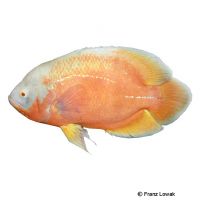Red Albino Oscar (Astronotus ocellatus 'Red Albino')
| Red Albino Oscar Astronotus ocellatus 'Red Albino' | |
|---|---|
| Name | Red Albino Oscar |
| Name Lat. | Astronotus ocellatus 'Red Albino' |
| Family | Cichlids |
| Family lat. | Cichlidae |
| Order | Cichlids |
| Order lat. | Cichliformes |
| Origin | South America (breeding variety) |
| Habitat | Forest streams, ponds |
| Diet | Carnivore |
| pH | 6.0-8.0 |
| Behavior | Predatory |
| Keeping | Pair, group |
| Care Level | Difficult |
| Reproduction | Substrate spawner |
| Breeding | Moderately difficult |
| Life Span | 10-13 years |
| Protection | No |
| Metric Units | |
| Size | 25-35 cm |
| Temperature | 23-26 °C |
| Hardness | 5-20 °dH |
| Aquarium | ~ 750 l |
| US Units | |
| Size | 10"-14" |
| Temperature | 73-79 °F |
| Hardness | 89-356 ppm |
| Aquarium | ~ 200 gal |
Distribution and habitat
The Albino Red Peacock Cichlid is a breeding form. Peacock Eye Cichlids originate from the Amazon River basin in Peru, Colombia and Brazil southward to the Rio Paraguay. They live in calm, shallow waterways and ponds with soft mud and sand bottoms.
Maintenance
The aquarium should have soft, slightly acidic water and robust planting that provides both shelter and swimming space, with roots and rocks as hiding places. A deep, dark sandy substrate and some subdued light (floating plants) are ideal.
There should be no detectable ammonia, ammonium or nitrite, and the nitrate level should not exceed 100 mg/l. To ensure the water quality and oxygen content, a filter and heater adapted to the aquarium size is required, as well as lighting for the species-appropriate day-night rhythm of the animals.
Diet
The food supply for these greedy eaters consists of live, frozen and dry food. For a balanced diet, feed once a day with a high-quality, protein-rich dry food for large cichlids (flakes, granules, pellets) and according to their size with mosquito larvae, krill, shrimp, crayfish, snails, earthworms, etc. (live or frozen).
Only feed as much as will be eaten within a few minutes. Regular and varied feeding promotes health and increases resistance.
Behaviour and compatibility
Peacock cichlids should be kept in pairs. Group keeping is only possible in larger, richly structured tanks. They are peaceful, calm animals that are only territorial during spawning season, and they should only be socialized with other calm and large fish. Fish that are too small are considered food.
Basically, only compatible fish species with similar water condition and water temperature requirements should be socialized.
Sex dimorphism
A reliable sex differentiation can only be recognized during mating, by the genital papilla of the female.
Reproduction and breeding
The female spawns on a previously cleaned stone (open brooder). The parents perform brood care and defend the clutch (1,000-2,000 eggs). After 3-4 days, the fry hatch and are housed in a depression dug by the parents. The school of fry continues to be sheltered and led to feeding sites in the aquarium for some time before brood care ends.
Fry must be fed several times a day with special rearing food (Artemia, Cyclops). In a community tank breeding is hardly possible, because the fry are easy prey.
Important
Peacock-eyed cichlids are bred in several color varieties.
They like to burrow, accordingly the plants should be placed in pots and secured with stones against burrowing out.
Commercially available color food should be offered to maintain their color. Improperly fed animals lose their intense coloration over time.
The well-being of the fish should be checked regularly. Temperature should be checked daily, pH, hardness and nitrate levels at least every 14 days. Regular partial water changes are recommended, even if the pollutant load has not yet reached the upper limit. Sudden changes in water quality should be avoided. Newly introduced fish must be accustomed slowly to the water in the aquarium.
Further literature can be found in your pet store.
References
Text: petdata; Image: Franz Lowak
Source: BMEL (1998): Tierschutzgutachten - Haltung von Zierfischen (Süßwasser); RIEHL & BAENSCH (2006): Aquarien Atlas Bd. 1, Mergus Verlag; ENGELMANN (2005): Zootierhaltung - Tiere in menschlicher Obhut: Fische, Verlag Harri Deutsch
- Gemäß § 21 Abs. 5 Tierschutzgesetz idgF
